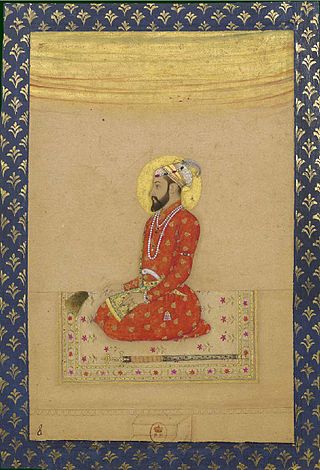
Mirza Muhammad Mu'azzam, commonly known as Bahadur Shah I and Shah Alam I, was the eighth Mughal Emperor from 1707 to 1712. He was the second son of the sixth Mughal Emperor Aurangzeb, who he conspired to overthrow in his youth. He was also governor of the imperial provinces of Agra, Kabul and Lahore and had to face revolts of Rajputs and Sikhs.
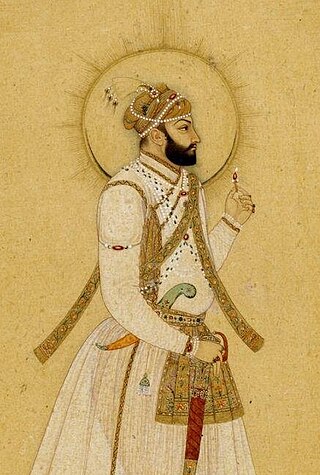
Farrukhsiyar, also spelled as Farrukh Siyar, was the tenth Mughal Emperor from 1713 to 1719. He rose to the throne after deposing his uncle Jahandar Shah. He was an emperor only in name, with all effective power in the hands of the courtier Sayyid brothers. He was born during the reign of his great-grandfather Aurangzeb, Reportedly a handsome man who was easily swayed by his advisers, he was said to lack the ability, knowledge and character to rule independently. Farrukhsiyar was the son of Azim-ush-Shan, the second son of emperor Bahadur Shah I and Sahiba Niswan. He was assassinated by Maharaja Ajit Singh of Marwar.
Dal Khalsa was the name of the combined military forces of 11 Sikh misls that operated in the 18th century (1748–1799) in the Punjab region. It was established by Nawab Kapur Singh in late 1740s.
Guru Nanak founded the Sikh religion in the Punjab region of the northern part of the Indian subcontinent in the 15th century and opposed many traditional practices like fasting, Upanayana, idolatry, caste system, ascetism, azan, economic materialism, and gender discrimination.

Jassa Singh Ramgarhia (1723–1803) was a prominent Sikh leader during the period of the Sikh Confederacy. He was the founder of the Ramgarhia Misl.
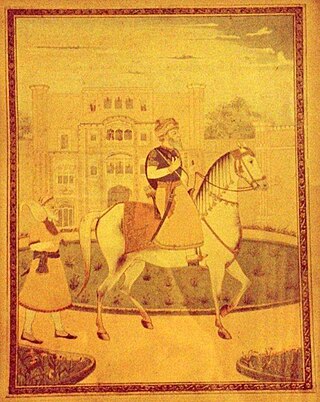
Jassa Singh Ahluwalia was a Sikh leader during the period of the Sikh Confederacy, being the supreme leader of the Dal Khalsa. He was also Misldar of the Ahluwalia Misl. This period was an interlude, lasting roughly from the time of the death of Banda Bahadur in 1716 to the founding of the Sikh Empire in 1801. He founded the Kapurthala State in 1772.
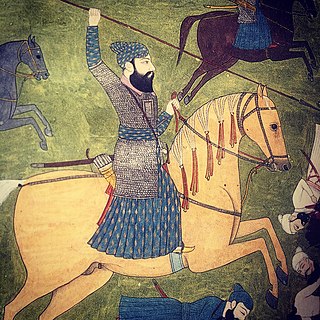
Banda Singh Bahadur, was a Sikh warrior and a general of the Khalsa Army. At age 15, he left home to become an ascetic, and was given the name Madho Das Bairagi. He established a monastery at Nānded, on the bank of the river Godāvarī. In 1707, Guru Gobind Singh accepted an invitation to meet Mughal Emperor Bahadur Shah I in southern India, he visited Banda Singh Bahadur in 1708. Banda became disciple of Guru Gobind Singh and was given a new name, Gurbaksh Singh(as written in Mahan Kosh), after the baptism ceremony. He is popularly known as Banda Singh Bahadur. He was given five arrows by the Guru as a blessing for the battles ahead. He came to Khanda, Sonipat and assembled a fighting force and led the struggle against the Mughal Empire.

Binod Singh, a Trehan Khatri and a descendant of Guru Angad, was an army man and disciple of Guru Gobind Singh and was among few Sikhs who accompanied him to Nanded in 1706. In Budha Dal Chronicles, Guru Gobind Singh made Baba Binod Singh the head of the Khalsa.
The siege of Sirhind was fought between the Mughal Empire and Sikh forces in 1710. The Sikhs besieged, stormed, captured, plundered and razed the city of Sirhind after defeating and beheading Wazir Khan in the Battle of Chappar Chiri.
The Battle of Samana was fought between the Khalsa under the leadership of Banda Singh Bahadur and the Mughal Government of Samana in 1709. Following the battle, Banda Singh Bahadur shook the administration of Delhi.
The siege of Jalalabad occurred in 1710 between the Mughal forces of Jalal Khan and the Sikh forces of Banda Singh Bahadur. Banda Singh Bahadur attacked the Mughal stronghold of Jalalabad. The army opposing Banda Singh was composed of a sizeable number of the Mughal zamindars and shurafa, including many Sadat, Banda Singh Bahadur repelled Mughal and Pathan forces after four days from the battlefield and back into the town, but failed to capture the town and withdrew.

The Battle of Chappar Chiri, also called Battle of Sirhind, was fought between Mughal Empire and the Sikhs on 12 May 1710 at Chappar Chiri, located 20 kilometers from Sirhind.
The Battle of Sadhaura was fought between Sikhs and the Mughal, Sayyid, and Shaykh forces in Sadhaura in 1710. The imperial forces were defeated and took refuge behind the city's walls. Banda's forces captured the fort and levelled it to the ground. It resulted in a victory for the Sikhs where Banda Singh Bahadur defeated Osman Khan.

The Battle of Rahon was fought between Sikhs and Mughal Empire on 11 October 1710.

The Battle of Sonipat was fought between Sikhs and the Mughal Empire in 1709. It was the first significant battle during Banda Singh Bahadur's conquests.
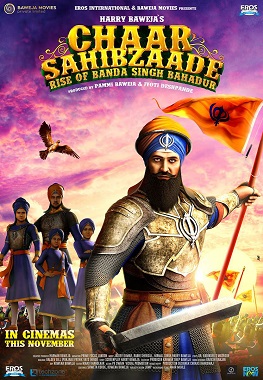
Chaar Sahibzaade 2: Rise of Banda Singh Bahadur is 2016 Indian Punjabi-language animated film, directed and produced by Harry Baweja. It is a sequel to the 2014 film Chaar Sahibzaade. The film was released on 11 November 2016.
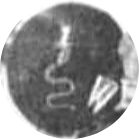
The Khalsa Fauj were the military forces of the Khalsa order of the Sikhs, established by the tenth guru, Guru Gobind Singh, in 1699. It replaced the Akal Sena that had been established by the sixth guru, Guru Hargobind.
The Battle of Bilaspur was fought in 1711 by Sikh forces led by Banda Singh Bahadur and the rulers of the Sivalik Hills led by Raja Ajmer Chand of Princely State of Kahlur (Bilaspur).
The Siege of Kotla Begum was fought in September 1710 between the Sikh forces and Mughal forces led by Mir Mohammad.

The First Sikh State was a breakaway and short lived sovereign Sikh state during the 18th century in the Punjab region of the Indian subcontinent that existed from 1709 to 1715. It was established by Banda Singh Bahadur after the Battle of Samana and lasted until his defeat in the Battle of Gurdas Nangal.










